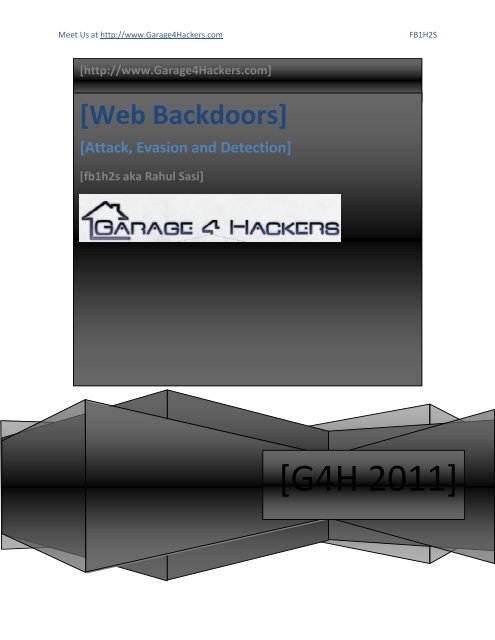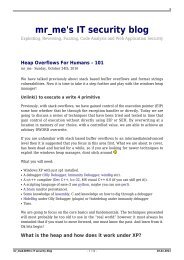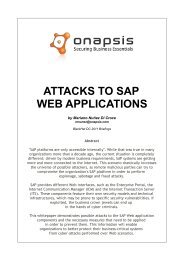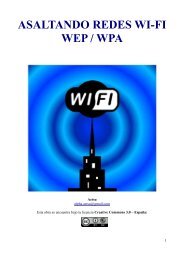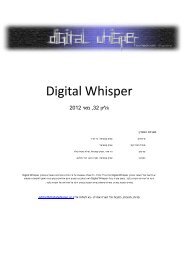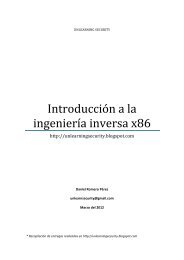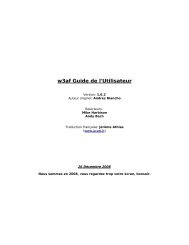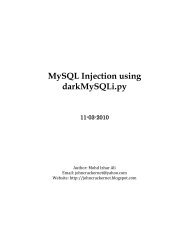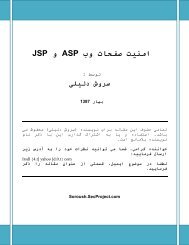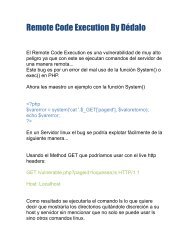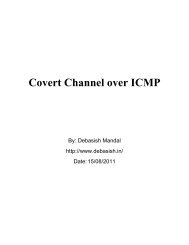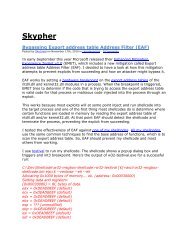Web backdoors evasion detection
Web backdoors evasion detection
Web backdoors evasion detection
Create successful ePaper yourself
Turn your PDF publications into a flip-book with our unique Google optimized e-Paper software.
Meet Us at http://www.Garage4Hackers.com<br />
FB1H2S<br />
[http://www.Garage4Hackers.com]<br />
[<strong>Web</strong> Backdoors]<br />
[Attack, Evasion and Detection]<br />
[fb1h2s aka Rahul Sasi]<br />
[G4H 2011]
Meet Us at http://www.Garage4Hackers.com<br />
FB1H2S<br />
Abstract: This paper provides insight on common web back doors and how simple manipulations could<br />
make them undetectable by AV and other security suits. Paper explains few techniques that could be<br />
used to render undetectable and unnoticed <strong>backdoors</strong> inside web applications.<br />
This paper is mainly an update for an old paper of ours Effectiveness of Antivirus in Detecting <strong>Web</strong><br />
Application Backdoors, which mainly questioned the effectiveness of AV with respect to web shells and<br />
analysis of a couple of web shells. Current paper takes this topic further and explains a couple of<br />
methodologies that could be used to make stealth application layer <strong>backdoors</strong> using web scripting<br />
languages .This paper explains various <strong>Web</strong> Backdoor attacks and <strong>evasion</strong> techniques that could be used<br />
to stay undetected .<br />
<strong>Web</strong> Application Backdoors:<br />
They are simple scripts built using web applications programs that would serve an attacker as a<br />
backdoor to the application hosting environment.<br />
Detection Methods [Signature Based Detection]<br />
In this technique the Antivirus software’s need to have the signature of the Backdoor, and for that the<br />
companies should already have had a copy of the backdoor for analyzing.<br />
Evading Signature Based Detection:<br />
We have previously documented how easy it was to bypass signature based <strong>detection</strong>. Based on further<br />
analysis we were able to conclude that, all most all AV use simple md5 check sum as signature for<br />
detecting common <strong>Web</strong> <strong>backdoors</strong> or simple text based signatures, though AV using MD5 or other<br />
check sum for <strong>detection</strong> is not any new news. This could be a night mare for many sys admin.<br />
A very common backdoor named cybershell.php was scanned with Total Av scanner and following were<br />
the results.<br />
#Analysis 1.1<br />
Sample md5:<br />
File Name:<br />
ef8828e0bc0641a655de3932199c0527<br />
cybershell.php<br />
Submission date: 2011-08-29 12:00:02 (UTC)<br />
Result: 20 /44 (45.5%)
Meet Us at http://www.Garage4Hackers.com<br />
FB1H2S<br />
So for bypassing this it is pretty easy, just add an extra comment line inside the code or strip out few<br />
strings from the code and that would be it.<br />
#Analysis 1.2<br />
Sample md5:<br />
File Name:<br />
251e62025daf17be22a028baa8d2b506<br />
cybershell.php<br />
Submission date: 2011-08-29 12:20:42 (UTC)<br />
Result: 0 /44 (00.00%)<br />
We have already documented on how easy it is to bypass AV <strong>detection</strong> of web <strong>backdoors</strong> and its pretty<br />
simple and making a document for that it is pointless. May be better ways of detecting them would be a<br />
good scope of research.<br />
Moving on to the main paper, since that we know by now that AV are of no use detecting <strong>Web</strong><br />
<strong>backdoors</strong>, there is no point in finding <strong>evasion</strong> techniques for them. But there are a handful of good<br />
tools and scripts that could scan and detect such <strong>backdoors</strong>. And also a server admin who is browsing<br />
though the source of his web server could easily figure out these ugly <strong>backdoors</strong>. So this paper would be<br />
mainly on how to evade these situations (examples would be in php).<br />
<strong>Web</strong> Backdoor Shell Detection on Servers (Specialized Tools)<br />
As documented here , the following are few specialized tools that are effective and<br />
1. <strong>Web</strong> Shell Detection Using NeoPI - A python Script<br />
(https://github.com/Neohapsis/NeoPI)<br />
2. PHP Shell Scanner - A perl Script<br />
(http://ketan.lithiumfox.com/doku.php?id=phpshell_scanner)<br />
3. PHP script to find malicious code on a hacked server - A PHP Script<br />
(http://25yearsofprogramming.com/blog/2010/20100315.htm)<br />
So the logic used by most of these scanners is simply to find all reference to the following<br />
function calls, these functions are mainly used for file management and OS command execution<br />
and are unavoidable parts in web shells.<br />
grep -RPn<br />
"(system|phpinfo|pcntl_exec|python_eval|base64_decode|gzip|mkdir|fopen|fclose|read<br />
file|passthru)" /pathto/webdir/
Meet Us at http://www.Garage4Hackers.com<br />
FB1H2S<br />
NeoPI<br />
NeoPI is a Python script that uses a variety of statistical methods to detect obfuscated and<br />
encrypted content within text and script files. The intended purpose of NeoPI is to aid in the<br />
identification of hidden web shell code. The development focus of NeoPI was creating a tool<br />
that could be used in conjunction with other established <strong>detection</strong> methods such as Linux<br />
Malware Detect or traditional signature/keyword based searches.<br />
[Source]<br />
In the above list NeoPI provides better result than the rest and we will concentrate dealing with this<br />
particular tool. One issues with these tools are, manual assessment is very much required since there<br />
are a lot of false positives.<br />
Few Backdoor codes these scanners will detect.<br />
Php Back tick Method<br />
<br />
//Php Back tick Method<br />
Any code containing any of the above mentioned black listed functions would be caught.<br />
elseif (is_callable("system") and !in_array("system",$disablefunc)) {$v =<br />
@ob_get_contents(); @ob_clean(); system($cmd); $result = @ob_get_contents();<br />
@ob_clean(); echo $v;}<br />
The following would be detected as NEOIP has got a mechanism to scan check for natural language, and<br />
the series of encoded values would be flagged.<br />
$code =<br />
“aGVsbG8gYWxsIHRoaXMgaXMganVzdCBhIHRlc3QgZm9yIHRoZSBwYXBlciBub3RoaW5nIGJh<br />
ZCBidWhhIGhhIGhhIGhlbGxvIGFsbCB0aGlzIGlzIGp1c3QgYSB0ZXN0IGZvciB0aGUgcGFwZXIgb<br />
m90aGluZyBiYWQgYnVoYSBoYSBoYWhlbGxvIGFsbCB0aGlzIGlzIGp1c3QgYSB0ZXN0IGZvciB0a<br />
GUgcGFwZXIgbm90aGluZyBiYWQgYnVoYSBoYSBoYWhlbGxvIGFsbCB0aGlzIGlzIGp1c3QgYSB0<br />
ZXN0IGZvciB0aGUgcGFwZXIgbm90aGluZyBiYWQgYnVoYSBoYSBoYQ==”<br />
Decodethis($code)
Meet Us at http://www.Garage4Hackers.com<br />
FB1H2S<br />
Evasion Techniques<br />
Evasion #1:<br />
Situation: Admin Might Scan his server with one of the above tools.<br />
Evasion:<br />
Php supports Variable Function :<br />
// following code is detected as base64_decode is detected as malicious<br />
content by one of the above tools<br />
Meet Us at http://www.Garage4Hackers.com<br />
FB1H2S<br />
Evasion #2:<br />
Situation: Admin manually searches through source code, he could possibly get suspicious the<br />
string like base64 etc, he might spot large encoded strings in his web application files.<br />
Evasion: A simple <strong>evasion</strong> for making this work would be to make the backdoor code as small<br />
as possible; so that it could be included with other code and remain undetected.<br />
<br />
It could be further shortened to the following format<br />
<br />
These small few lines of code would be able to give command execution. It would be<br />
completely undetectable by any of the above tools and not easily by manual code audits.<br />
Changing the above code from using GET request to POST request would prevent it from<br />
showing up in logs files too.
Meet Us at http://www.Garage4Hackers.com<br />
FB1H2S<br />
Evasion #3:<br />
Situation: The applications are audited using some source code audit scanners that detect all<br />
possible user inputs fields and traces possible code injection attacks. Thus taking the input via<br />
_GET and _POST method might get detected.<br />
Evasion:<br />
It’s possible to place data inside JPEG EXIF headers, so we will put all function calls and data<br />
inside an image and assemble them at runtime, that way the inputs would be coming not form<br />
user but form a local source .<br />
<br />
Here image.jpeg, could contain all our php code and shell codes, and the exif_read_data tag<br />
could be used to call individual meta tags and function calls could be constructed at runtime.<br />
Similarly we could hide a reverse shell inside an image and place it inside the index page, so<br />
whenever a request to the main page is made with a particular HTTP Header our backdoor<br />
would be triggered, this way it would be less noisy and undetectable by AV, code audits, and any<br />
backdoor hunting script.<br />
Note: An alternate for eval would be using the preg_replace() function with /e switch :<br />
Meet Us at http://www.Garage4Hackers.com<br />
FB1H2S<br />
Demo:<br />
The above small piece of code is injected into index page of a compromised site.<br />
The image with the actual malicious code is added to sites /images directory.<br />
Code is triggered on a particular HTTP header may be user_agent == w1d0ws.<br />
On accessing the index page we will get a reverse shell.<br />
Benefits:<br />
Backdoor remains undetected from shell scanners and AV<br />
Remains undetected form code auditing software’s.<br />
No traces in log files<br />
Here is how it looks:<br />
Am an innocent page <br />
Request:
Meet Us at http://www.Garage4Hackers.com<br />
FB1H2S<br />
Shell Obtained:<br />
Improvements:<br />
The POC code/demo would have a PHP code that would be able to load shell codes and provide connect<br />
back shell.<br />
Thanks for Reading,<br />
Fb1h2s @ gmail.com<br />
http://www.Garage4Hackers.com<br />
[This paper was presented and demos were given at C0C0N Sec Conference 2011 Oct -9 ]


